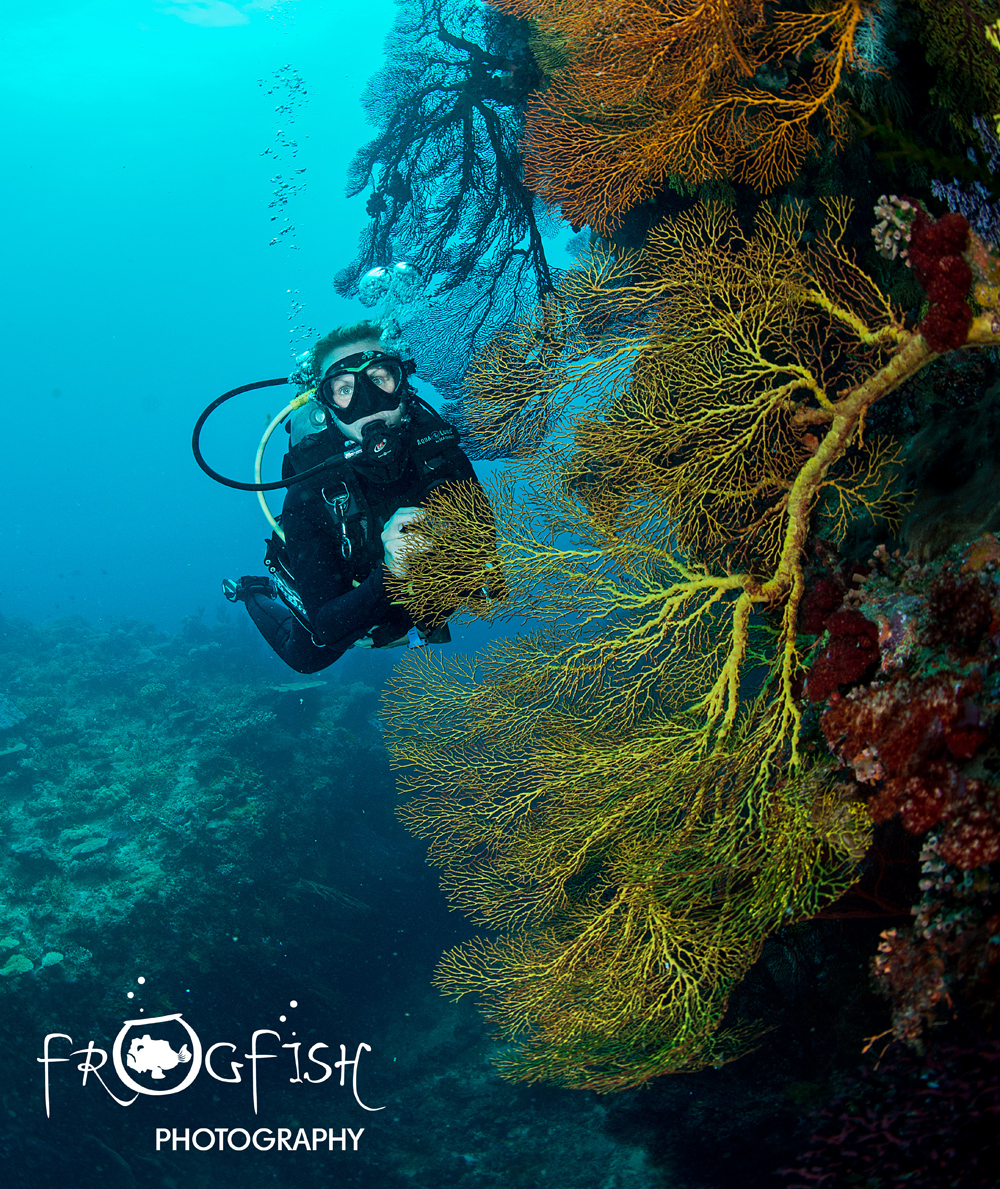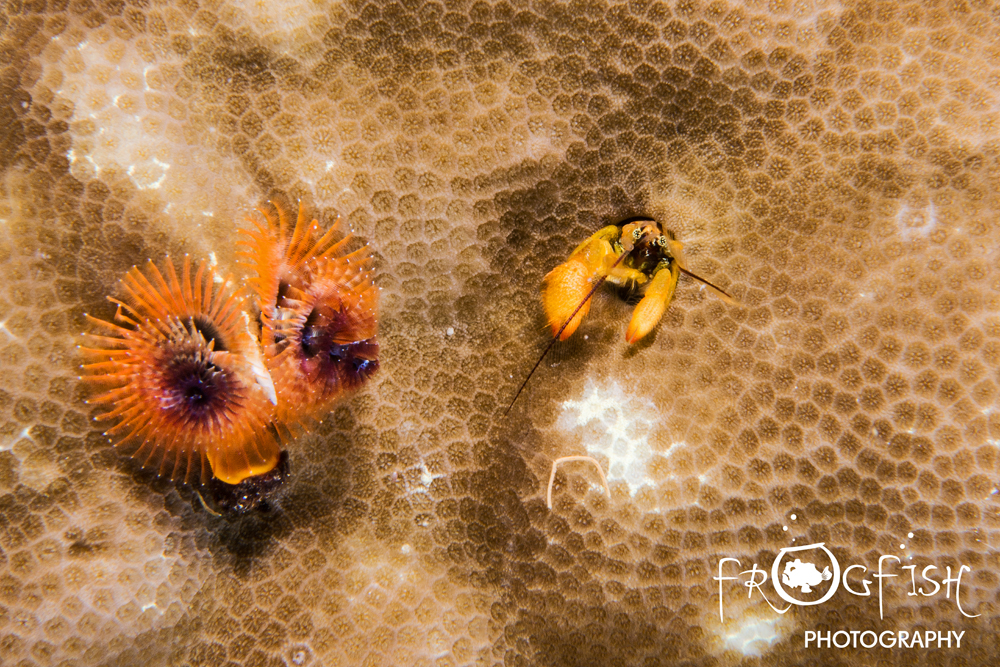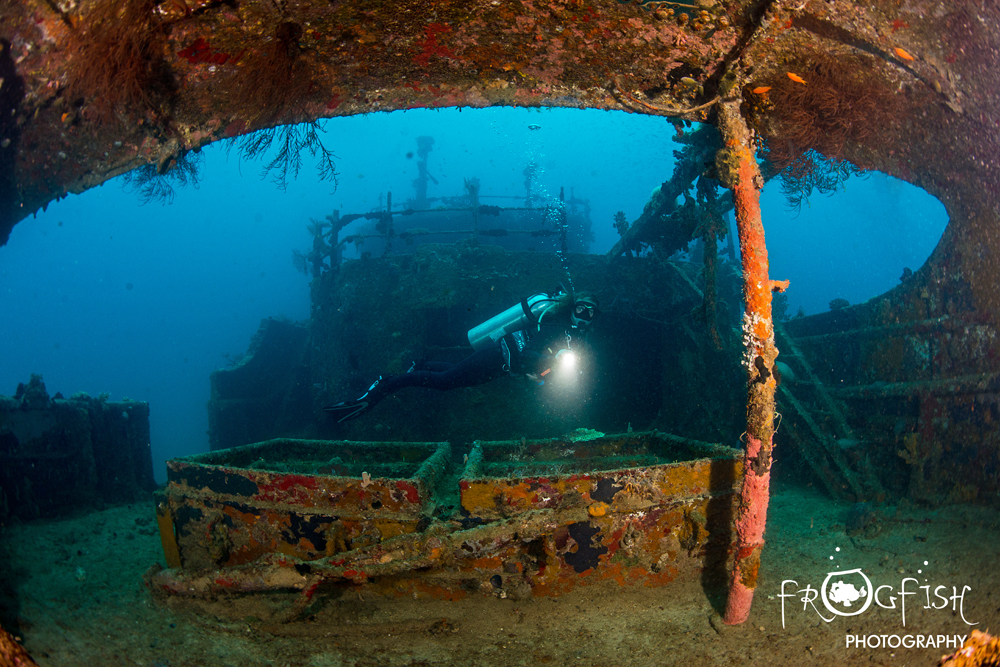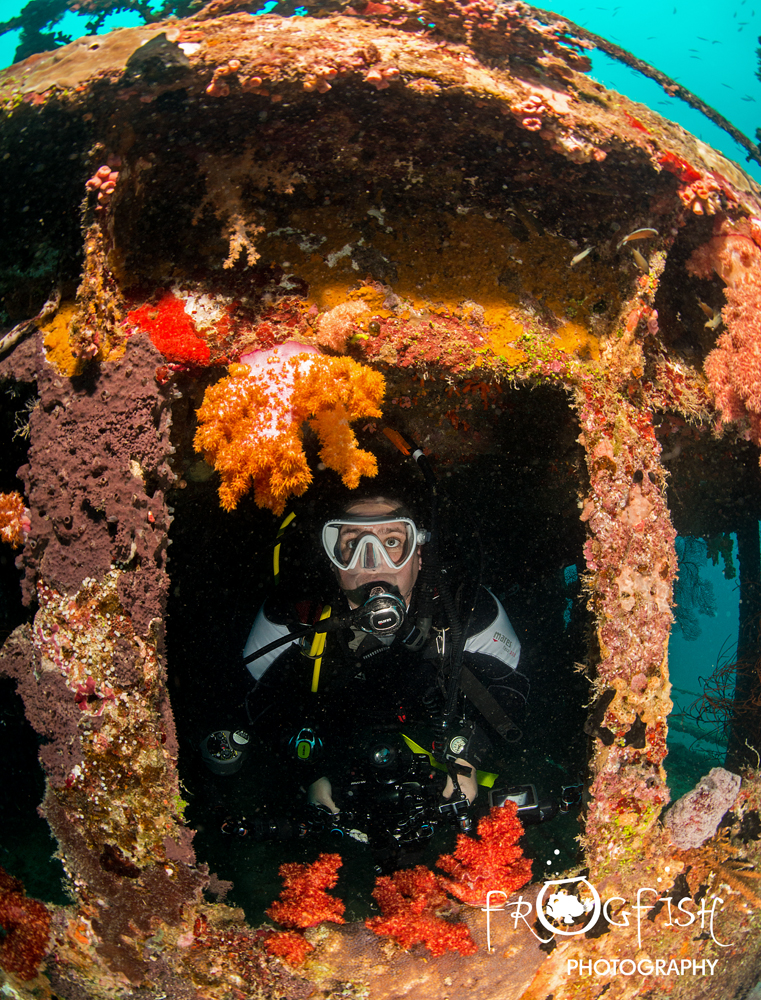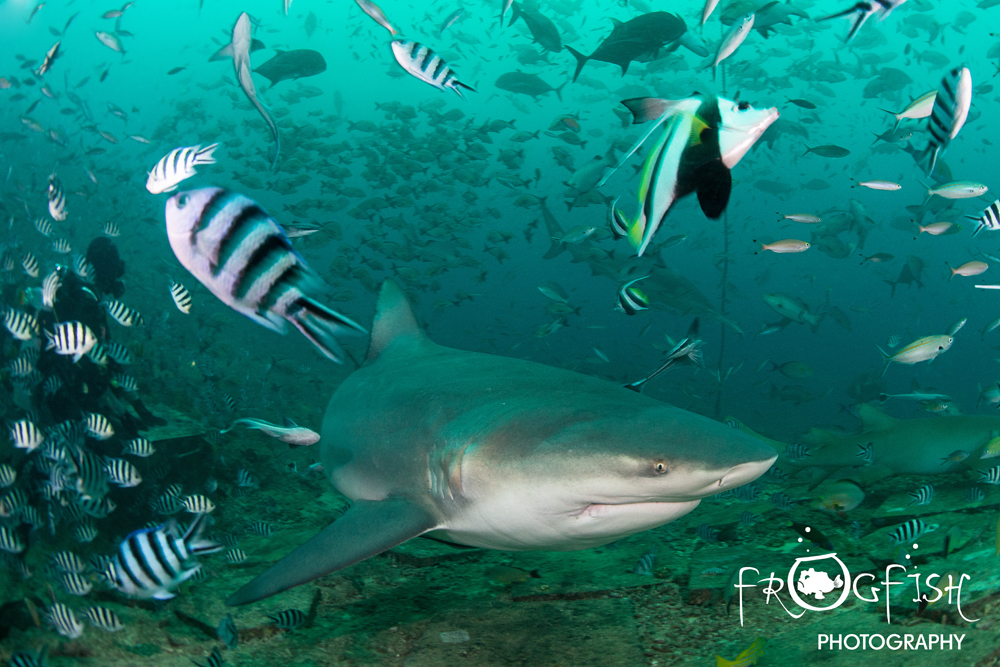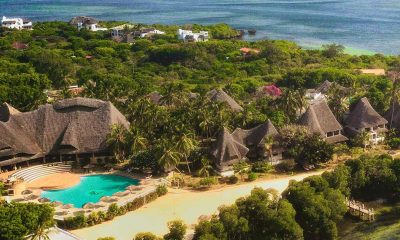News
Wonderful Waidroka
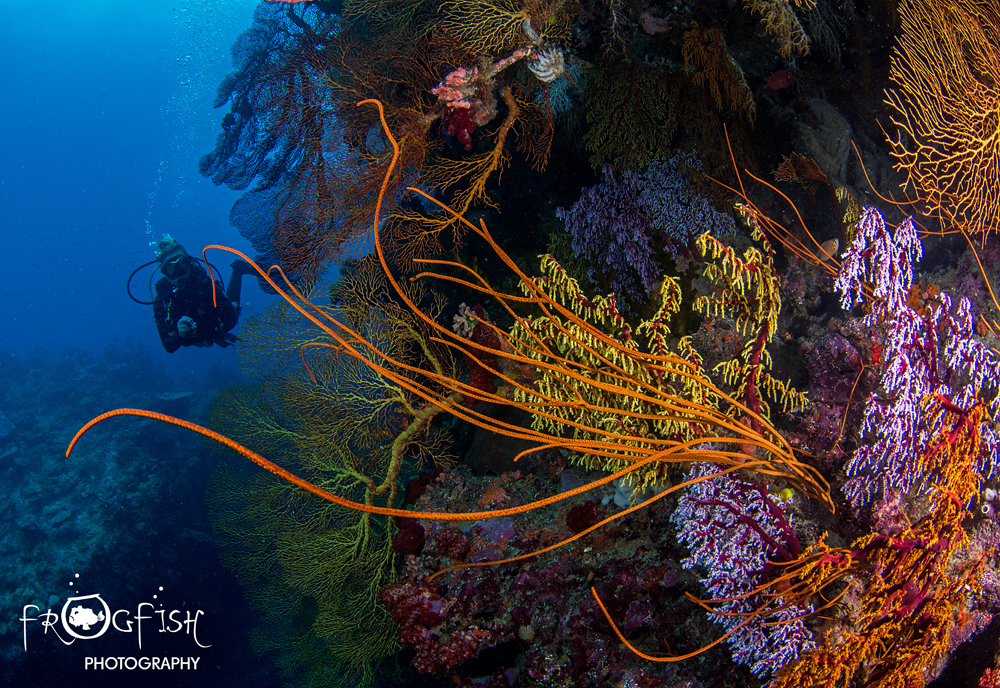
There is nothing like getting a warm welcome from all the staff when you first arrive at a resort, particularly when you are feeling more than slightly bedraggled from your journey. At Waidroka Bay Resort, we soon felt completely at home, and with all our bags whisked to our ocean front Bure (Fijian style bungalow), before we knew it, we were sat with the dive staff chatting about what the diving had to offer us the following day. We were to be the only divers on the boat, as a group had just left, which meant we had the choice of where to go – so we asked for them to take us to their favourite sites, of course!
All the meals at Waidroka are served “family style” with the guests and staff sitting around a communal table. You can opt to sit at a more private table or outside if you wish, but most like to sit and chat about the days diving and surfing with each other. The chef at Waidroka recently won Young Fiji Chef of the Year, which is an amazing accolade, and the food clearly reflected his talent. Not only was it delicious, but beautifully presented as well.
Our first day of diving was going to be based around the island of Yanuca. The dive centre has a close association with the villagers here, and the staff come to teach the school kids about the marine environment and wildlife each week. For us, it is the perfect place to relax between dives over a cup of tea, or lunch, whilst parked in the sheltered and secluded bay, with kids running around on the beach in the background. December is mid-summer here, so the schools were on a six week break.
Our first dive was at a site called Fantasea 1. Our guides, and head of watersports operations, Chelle and Warren, raved about this dive, so we just hoped it would live up to their enthusiastic tales. This has to be one of the best coral dive sites we have ever been on – no really! Fiji is famous for its reef diving, and this resort is at the heart of the Coral Coast, but even so, we were blown away by this dive site. Everywhere we looked the reef was packed with brightly coloured gorgonians, a rainbow of broccoli corals and numerous fish and critters hiding away on this fabulous reef. Chelle posed for us on the wall, diving through overhangs, gullies and swim-throughs, and with a maximum of 18m we stayed for well over an hour! How were we going to match this?
On our surface interval, we chatted about where to go next. Warren and Chelle told us about a site that was nearby, the Tasu II Wreck. Sunk in 1994, this was a 200 tonne Taiwanese fishing vessel, which had been confiscated for illegal fishing and deliberately sunk to create an artificial reef. She sits upright in the sand at just over 20m, depending on the tides. After over 20 years, plenty of animals have made their home here, and Warren went off to find the tiny pipefish that live on the roof of the wheelhouse, while we weaved our way around the structure, photographing the windows adorned with sea fans and capturing images of each of us framing our faces in the gaps. The dive is not over once you have finished exploring the wreck though, as you can extend your bottom time by swimming the short distance to Seven Sisters reef, a series of seven pinnacles that reach up to 5m, so you can select your safety stop pinnacle. Anthias, in pink and orange, in their thousands pulse to the rhythm of your breathing and strobe guns. It is truly magical.
Back at Yanuca Island, we relax and have some lunch. The chef has prepared packed lunches for each of us, which we are ready for. Our final dive site was another assault on our senses. Vivid colours on every available surface; it is easy to see why Cousteau called Fiji “the soft coral capital of the world”.
Alas, an incoming front was causing the wind to pick-up and we were starting to get worried about the diving being cancelled the next day. You could see that we were not the only ones concerned as Warren kept disappearing to check his weather apps over the course of the evening. After another scrumptious dinner, he called us over to brief us on the shark diving that we were due to do in the morning. The diving was going to depend on the weather in the morning, so we had everything crossed – this was one dive we had been looking forward to for weeks.
The shark dive that the Waidroka team take you on is run by the founders of this event, Aqua-Trek. The boat ride to Beqa (pronounced Benga) Lagoon is about 30 minutes away, and, whilst the weather was not ideal, we were delighted that the dive had not been cancelled and eagerly jumped on-board. Heavy rain overnight meant that the water was looking a little green from the run off from local rivers. However, it also kept away many of the boats that would usually come for this dive, so at least we could look forward to a more personal experience. Aqua-Trek’s boat pulled up with only 4 or 5 divers, so there would only be 7 divers, plus the shark feeders and wranglers in the water. As Fiji has some strong currents, the dive site is setup with a series of lines to guide you down to the correct shark feed location. The main stars of the show are Bull and Tiger Sharks, although you may also see Lemon, Nurse and various species of reef shark as well. The divers line up behind a wall, with the feeders in front to tempt in the sharks with fish heads that are donated by local fishermen and resorts. Usually it is the Bull Sharks that get the food, with the other species being wary of getting in their way, and you can see why when you get on the dive. Even with the visibility reduced and the water a little green, the experience is incredible, as huge bull sharks come in for their snacks. Surprisingly, they do so in an astonishingly calm manner, never rushing and appear content to circle around if another is already feeding. We were very fortunate to be invited into the feeding circle to kneel next to the feeders for an even closer encounter. One Bull Shark took a liking to Nick and came right up to his camera, stopping just in front of the dome port to say hello, before the wranglers gave her a polite nudge to move her along. All too soon, it was time to end the dive. We stayed as long as we were allowed to watch these magnificent sharks circle below us, but the visibility was getting worse, and we had to head back to the boat.
Alas, the weather finally beat us, and the second shark-feed dive was cancelled, as the visibility was getting worse, and the shark feeders could not see the sharks coming. It was the right call, but we were bitterly disappointed. We just had to remind ourselves how privileged we had been to get the first dive at all. The waves had also picked up, so the boat captain was eager to get us back closer to the resort. Within the reef system, the waters were a bit calmer, and so we decided to pop-in and dive one of the teaching sites near the resort. Waidroka has a pontoon for guests to sunbathe on and to use as a base for snorkelling and swimming. The best thing about it, though, if you look closely between the wooden slats, is that this is where many of the Banded Sea Kraits (sea snakes) come to warm themselves during the day. It is the first time we have seen this behaviour.
Our final night was to be a traditional Fijian evening of Lovo (food cooked in a BBQ pit), Kava (the local drink made from pepper plant roots) and music. We donned our Fiji Tourism Sulus (traditional Fijian skirts) and Scubaverse polo shirts and joined in the fun, the music and dancing. It was with not a small amount of sadness though, as we were leaving in the morning and, quite rarely for us, we really did not want to depart! We loved our time at Waidroka. The diving was great, the staff were all wonderful and so the whole experience was a joy. Maybe we will be able to come back sometime; we would certainly jump at the opportunity.
Find out more about Nick and Caroline at www.frogfishphotography.com.
Blogs
The Ocean Cleanup Breaks 10,000,000 KG Barrier

The Ocean Cleanup, the global non-profit project, has removed a verified all-time total of ten million kilograms (22 million lbs.) of trash from oceans and rivers around the world – approximately the same weight as the Eiffel Tower.
To complete its mission of ridding the oceans of plastic, The Ocean Cleanup uses a dual strategy: cleaning up the Great Pacific Garbage Patch (GPGP) to remove the plastic already afloat in the oceans, while stopping the flow of plastic from the world’s most polluting rivers.
Through cleaning operations in the GPGP and in rivers in eight countries, the cumulative total of trash removed has now surpassed ten million kilograms. This milestone demonstrates the acceleration of The Ocean Cleanup’s impact, while underlining the astonishing scale of the plastic pollution problem and the need for continued support and action.
While encouraging for the mission, this milestone is only a staging point: millions more tons of plastic still pollute our oceans and The Ocean Cleanup intends to continue learning, improving and innovating to solve this global catastrophe.
This announcement comes as governments from around the world meet to continue negotiations to develop a new legally binding instrument to end plastic pollution at INC4 in Ottawa, Canada. Representatives of The Ocean Cleanup will be in attendance and the organization will be urging decision-makers to collaborate towards a comprehensive and ambitious global treaty which addresses plastic at all stages of its life cycle and in all marine environments worldwide, including in areas beyond national jurisdiction.
It is encouraging to see that the need for remediation is reflected in the various options for potential treaty provisions. It is essential that the final treaty contains clear targets for the remediation of legacy plastic pollution, and reduction of riverine plastic emissions.
Tackling plastic pollution requires innovative and impactful solutions. The treaty should therefore incentivize the innovation ecosystem by fostering innovations that make maximal use of data, technology and scientific knowledge – such as those designed and deployed by The Ocean Cleanup.
‘After many tough years of trial and error, it’s amazing to see our work is starting to pay off – and I am proud of the team who has brought us to this point.’ said Boyan Slat, Founder and CEO of The Ocean Cleanup. ‘While we still have a long way to go, our recent successes fill us with renewed confidence that the oceans can be cleaned.’
The Ocean Cleanup was founded in 2013 and captured its first plastic in 2019, with the first confirmed catch in the GPGP coming soon after the deployment of Interceptor 001 in Jakarta, Indonesia. After surpassing one million kilograms of trash removed in early 2022, the non-profit project has since progressed to the third iteration of its GPGP cleaning solution, known as System 03, and a network of Interceptors currently covering rivers in eight countries, with more deployments set for 2024.
About The Ocean Cleanup
The Ocean Cleanup is an international non-profit organization that develops and scales technologies to rid the world’s oceans of plastic. They aim to achieve this goal through a dual strategy: stemming the inflow via rivers and cleaning up the legacy plastic that has already accumulated in the ocean. For the latter, The Ocean Cleanup develops large-scale systems to efficiently concentrate the plastic for periodic removal. This plastic is tracked and traced through DNV’s chain of custody model to certify claims of origin when recycling it into new products. To curb the tide via rivers, The Ocean Cleanup has developed Interceptor™ solutions to halt and extract riverine plastic before it reaches the ocean. Founded in 2013 by Boyan Slat, The Ocean Cleanup now employs a broadly multi-disciplined team of approximately 140. The foundation is headquartered in Rotterdam, the Netherlands.
For more information, visit: theoceancleanup.com and follow @theoceancleanup on social media.
Marine Life & Conservation
Steve Backshall to headline Shark Trust’s flagship event: For the Love of Sharks

Join a host of amazing, shark loving, speakers including Steve Backshall and the Shark Trust team for an evening celebrating shark conservation at the Royal Geographical Society in London this November.
Date: 29th November 2024
Time: 6-10pm
Location: Royal Geographical Society, London
Tickets: https://www.sharktrust.org/Event/flos24
The event will be a celebration of all things shark. Those lucky enough to get hold of tickets will hear from engaging guest speakers with a passion for sharks.
The line-up includes (*subject to change if unforeseen circumstances arise)
Steve Backshall: One of television’s busiest presenters, BAFTA award-winning wildlife expert Steve has been passionate about the wild world ever since he was young.
Steve’s impressive TV career has taken him all around the world, investigating a wide array of species and environments. Steve has filmed over 100 hours of children’s wildlife programmes with the BAFTA award winning Deadly 60 franchise and recently, with Sky Nature, for his new series ‘Whale with Steve Backshall’. He has been a patron for the Shark Trust for 10 years.
Simon Rogerson: is a photojournalist specialising in natural history, diving and the sea.
He is editor of SCUBA magazine, the official journal of the British Sub-Aqua Club. Simon started his career as a crime reporter but gravitated towards his ‘less depressing’ interest in underwater exploration, joining the staff of DIVE magazine in 1999. In 2005 he was named ‘Editor of the Year’ in the PPA’s Independent Publishing Awards. Simon also works as a freelance writer, contributing frequently to the Sunday Times and Telegraph, in addition to BBC Wildlife, Esquire, and a host of international diving magazines. He is the author of a book, Dive Red Sea, published by Ultimate Sports. Now based in Berkshire, Simon has been a Patron of the Shark Trust for 20 years.
More speakers to be announced soon. Head to the Shark Trust website to learn more.
The evening will also allow guests the final chance to see the Oceanic 31, shark art exhibition. Some of the artwork will be auctioned/raffled at the event, while the rest will be auctioned online to raise money for the Shark Trust Oceanic Programme.
For the Love of Sharks is an evening with something for everyone who is interested and fascinated by sharks. Join the Shark Trust, their Patrons, Trustees and Staff, along with a host of supporters for this celebration of shark conservation.
For more information or to buy a ticket: https://www.sharktrust.org/Event/flos24
-

 News3 months ago
News3 months agoCapturing Critters in Lembeh Underwater Photography Workshop 2024: Event Roundup
-

 Marine Life & Conservation Blogs3 months ago
Marine Life & Conservation Blogs3 months agoCreature Feature: Swell Sharks
-

 Blogs2 months ago
Blogs2 months agoMurex Resorts: Passport to Paradise!
-

 Blogs2 months ago
Blogs2 months agoDiver Discovering Whale Skeletons Beneath Ice Judged World’s Best Underwater Photograph
-

 Gear Reviews3 weeks ago
Gear Reviews3 weeks agoGEAR REVIEW – Revolutionising Diving Comfort: The Sharkskin T2 Chillproof Suit
-

 Gear Reviews3 months ago
Gear Reviews3 months agoGear Review: Oceanic+ Dive Housing for iPhone
-

 Marine Life & Conservation2 months ago
Marine Life & Conservation2 months agoSave the Manatee Club launches brand new webcams at Silver Springs State Park, Florida
-

 News2 months ago
News2 months agoPADI Teams Up with Wellness Brand Neuro to Drive Ocean Change and Create a Blue State of Mind


